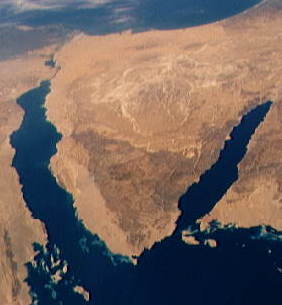Gulf of Aqaba

The Gulf of Aqaba (Arabic: خليج العقبة; transliterated: Khalyj al-'Aqabah), in Israel known as the Gulf of Eilat (Hebrew: מפרץ אילת, transliterated: Mifratz Eilat) is a large gulf of the Red Sea. It is located to the east of the Sinai peninsula and west of the Arabian mainland. Egypt, Israel, Jordan, and Saudi Arabia all have coastlines on the Gulf of Aqaba.
The Gulf of Aqaba is one of two gulfs created by the Sinai Peninsula's bifurcation of the northern Red Sea, the Gulf of Suez lying to the west of the Sinai Peninsula and the Gulf of Aqaba lying to its east. The Gulf of Aqaba measures 24 km at its widest point and stretches some 160 km north from the Straits of Tiran to a point where the border of Israel meets the borders of Egypt and Jordan. At this northern end of the Gulf are three important cities: Taba in Egypt, Eilat in Israel, and Aqaba in Jordan. All three cities serve both as strategically important commercial ports and as popular resort destinations for tourists seeking to enjoy the warm climate of the region, which is great for tourists. Further south, Haql is the largest Saudi Arabian city on the gulf. On Sinai, Sharm el-Sheikh and Dahab are the major centers.
The Gulf of Aqaba, like the coastal waters of the Red Sea, is one of the world's premier sites for diving.The area is especially rich in coral and other marine biodiversity and contains a number of underwater wrecks, some accidental shipwrecks, others vessels deliberately sunk in an effort to provide a habitat for marine organisms and bolster the local dive tourism industry.
Geologically, the Gulf of Aqaba is an integral part of the Great Rift Valley that runs from East Africa through the Red Sea and northwards towards the rift valley containing the Dead Sea.
Ron Wyatt claims to have discovered evidence that the Gulf of Aqaba was the body of water crossed by Moses during the Passage of the Red Sea as told in the Book of Exodus. He bases this on the fact that Egyptian chariots wheels were found 2/3 of the way up the gulf deep in the water. The wheels were confirmed by an Egyptologist to be genuine artifacts dating back to the 18th dynasty.[citation needed]
An Egyptian naval blockade against all Israeli shipping through the Straits of Tiran (the southern opening of this gulf) was the immediate cause of the 1967 Six Day War.[1]
Bold text==External links==
- The Red Sea Marine Peace Park page on Israel's Ministry of Foreign Affairs - a joint Israel-Jordan initiative
Credits
New World Encyclopedia writers and editors rewrote and completed the Wikipedia article in accordance with New World Encyclopedia standards. This article abides by terms of the Creative Commons CC-by-sa 3.0 License (CC-by-sa), which may be used and disseminated with proper attribution. Credit is due under the terms of this license that can reference both the New World Encyclopedia contributors and the selfless volunteer contributors of the Wikimedia Foundation. To cite this article click here for a list of acceptable citing formats.The history of earlier contributions by wikipedians is accessible to researchers here:
The history of this article since it was imported to New World Encyclopedia:
Note: Some restrictions may apply to use of individual images which are separately licensed.